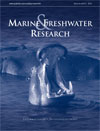Marine and Freshwater Research
Volume 64
Number 11 2013
Juvenile fish living in temperate environments must balance the need to out-grow predators with the accumulation of sufficient energy reserves to sustain them through winter. We investigated the resource allocation in juvenile Chrysophrys auratus and found that resource allocation changed from maximising growth in summer to maximising lipid accumulation in autumn. The timing of this shift in resource allocation is likely to affect recruitment variability of this important species.
Marine cyanobacteria are among the most abundant organisms and make a significant contribution to productivity. Examination of the influence of the Indian Ocean eastern boundary current on the distribution of Synechococcus spp. and Prochlorococcus spp. identified that mesoscale eddies strongly modified their distribution. The importance of eddies in the redistribution of cyanobacteria and plankton determines regional scale dynamics in productivity.
Coral reefs cannot exist without crustose coralline algae (CCA) and CCA are vulnerable to disease. Coralline lethal orange disease and coralline white-band syndrome were found to be ubiquitous on the Great Barrier Reef with localised outbreaks. Understanding the causes and effects of CCA disease outbreaks is vital at a time when coral reefs are under increasing threat from anthropogenic impacts globally.
White abalone (Haliotis sorenseni) is at high extinction risk and was the first marine invertebrate listed as an endangered species (Federal ESA). To address questions of age and growth for the remnant aging population, bomb radiocarbon (Δ14C) dating was used on large white abalone shells. The findings indicate lifespan approaches 30 years and restoration efforts are paramount to population recovery.
This study investigated fluctuations in seawater pH and the dissolved inorganic carbon (DIC) concentration brought about by photosynthetic activity of seagrasses and macroalgae. The diel variations of seawater pH were affected by light, plant biomass and species. The findings from this field-data collection indicated that the photosynthetic activity of marine macrophytes can alter the seawater pH, as well as the concentration of DIC, at the scale of a whole bay.
The role of habitat complexity in the availability of littoral–benthic Cladocera for predatory planktonic invertebrates was estimated in a series of laboratory experiments and under natural conditions. Predatory success of invertebrates resulted from spatial complexity of habitats, but it was also related to predatory type and specific traits of the prey. The presented study of interactions between littoral–benthic and pelagic invertebrates contribute to better understanding the nature of littoral–pelagic coupling.
Habitat availability is a determining factor for the sustainability of freshwater-fish populations and should be considered for management consideration. The spawning-habitat of an amphidromous goby was described based on egg-clutch distributions and showed a strong selection for microhabitat and mesohabitat conditions. The availability of favourable substratum may be a limiting factor for reproductive success.
Fisheries independent surveys on the shelf of New South Wales suggested that the overall fish biomass in the survey area had substantially decreased between 1976 and 1996. We have implemented an Atlantis ecosystem model and emulated the evolution of the shelf ecosystems from 1976 to 1996 and the observed decline of most of the commercial fish species in the Offshore Trawl Fishery. We also explore the effects of alternative fishing pressures on those ecosystems and demonstrated the competing nature of some of the ecosystem-based sustainable fishing objectives.
The east coast of southern Africa is host to a variety of biologically diverse systems that are becoming increasingly impacted by human activities. We examine trends in sedimentation and nutrient biogeochemistry in Lake Sibaya and relate these to recent changes in catchment land use. Nutrient enrichment is identified as a potential long-term problem and highlights the need for future monitoring efforts in other ecologically sensitive systems from the region.




